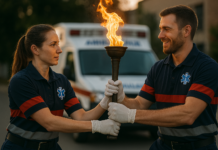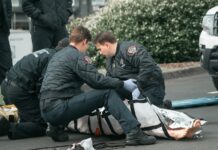Introduction
Accidental injury is the greatest cause of death among college students.1 Many types of injuries occur on college campuses, including motor vehicle collisions, construction and lab mishaps, and sports-related injuries. Moreover, campuses have been the scene of natural disasters, such as tornadoes, and human-made disasters, including active shooters and mass casualty events. Heightened awareness and vigilance regarding the risk of intentional attacks at colleges and universities is not new. Following the events of September 11th, 2001, the director of the Federal Bureau of Investigation referred to colleges as vulnerable and “soft” targets of terrorism.2 While intentional mass casualty events garner large attention from the media, the occurrence of everyday injuries occupies a larger sector of the spectrum of traumatic injury. Worldwide, injury is the leading cause of death in people ages 1-46, and hemorrhage accounts for greater than 35% of all prehospital deaths.3,4
The importance of early hemorrhage control to save lives in severely bleeding patients has evolved into a cornerstone of Tactical Combat Casualty Care (TCCC).5,6 This knowledge has been further adapted by civilian groups such as the Committee for Tactical Emergency Casualty Care (C-TECC), and is becoming standard practice for civilian law enforcement, as well as tactical and emergency medical services teams worldwide.7 Control of severe bleeding with tourniquet placement has been associated with a 6-fold increase in survival among civilian trauma patients.8 The Hartford Consensus, convened by the American College of Surgeons to enhance survival in mass causality and active shooter events, recommends that emergency responders and bystanders alike have both the knowledge and access to essential equipment to stop severe bleeding, similar to CPR and Automated External Defibrillators (AEDs) for sudden cardiac arrest.9,10 The Hartford Consensus recognizes and emphasizes the essential role of those present in the immediate aftermath of a traumatic injury event, highlighting that these “immediate responders” can initiate life-saving care prior to the arrival of trained personnel.11
The Stop the Bleed initiative calls for public access to bleeding control kits and training for the lay public on how to recognize and control severe bleeding. Since its inception in October 2015 (under President Barack Obama’s policy directive for national preparedness), training curricula have been developed and programs have placed bleeding control kits in various locations to include schools, airports, and communities nationwide.11,12 Calls to action have encouraged the continued development and broader universal implementation of bleeding control programs.13 For example, many states (including Maryland) require high school students to be trained in CPR to graduate from high school.14 Suggestions now exist for similar programs designing bleeding control education for high school students, or younger.15
The fundamental principles associated with calls to action for Stop the Bleed programs have broad applicability. These calls to action also coincide with an increase in intentional mass casualty events on schools and academic campuses, which have yielded wounds previously exclusive to the battlefield. The associated timeline of these events dates back nearly two decades starting with the 1999 Columbine High School Shooting (15 deceased, 24 injured); the Virginia Tech massacre (33 deceased, 23 injured); the 2012 Sandy Hook Elementary Shooting (28 deceased, 2 injured); the 2015 Umpqua Community College Shooting (10 deceased, 15 injured); 2018 Santa Fe High School Shooting (10 deceased, 14 injured) and the 2018 Marjorie Stoneman Douglas High School Shooting (17 deceased, 17 injured).16 Beyond those events that have occurred in or around academic campuses, other events have also occurred in venues where people congregate, such as night clubs (Pulse Night Club; Orlando, Florida: 49 deceased, >50 injured), houses of worship (First Baptist Church; Sutherland Springs, Texas: 26 deceased, 20 injured) and concerts (Mandalay Bay Resort and Casino; Las Vegas, Nevada: 58 deceased, ~500 injured). These events have served as a catalyst for a heightened focus on community awareness and civilian immediate-response capabilities.
Organizations such as the Scouts include tourniquets as a key point in their wilderness first aid curriculum.17 Furthermore, the story of Virginia Tech massacre survivor, Kevin Sterne, highlighted the importance of widespread knowledge of bleeding control. After being shot in his femoral artery, Sterne employed skills he had learned years before to make a makeshift tourniquet out of an electrical cord.18 Following the 2015 Paris Terror Attacks, the need for tourniquets was so great that the mobile teams had to improvise them with their belts after exhausting their own resources.19 During the 2017 Las Vegas mass shooting, bystanders used belts as makeshift tourniquets in the immediate aftermath of the event. Although the quick-thinking and skills of these heroes were paramount in saving lives, there is still more to be said and done. Studies have shown improvised tourniquets, such as belts, cravats, or wire, are likely to be “futile” due to insufficient force generated.20 Through bringing Stop the Bleed to the Johns Hopkins University (JHU) Homewood Campus, we hope to heighten awareness about the importance of rapid recognition and intervention of life threatening hemorrhage, provide training in how to control severe bleeding, and to improve access to bleeding control kits. We also hope that this program can serve as a model for others to follow.
The JHU Homewood Campus is located in urban Baltimore City, Maryland. In the fall term of 2017, the campus was home to 14,203 students (8,247 full-time and 5,956 part-time).21 The JHU campus emergency medical service, known as the Hopkins Emergency Response Organization (HERO), is a BLS, non-transporting unit that is in service 24/7 during the academic year and currently comprised of 66 EMS providers (64 EMTs, 1 EMT-I, and 1 Paramedic). HERO receives operational oversight along with medical direction from the Johns Hopkins Lifeline, the critical care transportation service for Johns Hopkins Hospital. HERO responds to medical emergencies with a minimum of one Field Training Officer (who responds via foot) and a Line Officer (who responds via response vehicle). In 2017, HERO had a 4-minute average response time for 314 calls. HERO works collaboratively with the Baltimore City Fire Department, which provides Advanced Life Support and transport capabilities.
In early 2017, HERO began a collaboration with faculty from the JHU School of Medicine’s Department of Emergency Medicine (ML, ERH) and the Department of Surgery, Division of Acute Care (ERH) to develop a strategy to introduce the Stop the Bleed Program to the Homewood undergraduate Campus of JHU. We have outlined the program design and implementation below.
1. Establish a Project Team & Outline A Plan
We first established the project’s goal of “Bringing Stop the Bleed to JHU undergraduate campus.” As we assembled a project team, the workgroup met by email, telephone and in-person to refine the plan for program implementation. From the beginning, specific objectives were created to prioritize and guide our focus and resources. These goals included training members of HERO in Stop the Bleed, acquiring bleeding control equipment for HERO responders, placing equipment in public access locations, and establishing the foreground for Stop the Bleed training to the entire JHU undergraduate community.
2. Create Short and Long-Term Training Goals
The first goal was to train all members of HERO; all active members received training in the American College of Surgeons Bleeding Control (BCon) course. Per the course guidelines, EMS providers with a BCon course certificate are able to register as instructors.22 The early training of HERO personnel in Stop the Bleed helped to motivate members and prepare them to teach BCon courses. We accomplished this goal while having concurrent, ongoing discussions with campus leadership regarding the training of other campus groups (eg, campus police officers). Future training goals included training students, faculty, and other staff members.
3. Perform a Needs Assessment to Guide Kit Placement
As part of our needs assessment, we used a campus map to identify locations for strategic placement of the Stop the Bleed kits based on predicted chance of use; we chose large lecture halls and the campus library because of their high occupancies. The recreation center was chosen due to the risk of major musculoskeletal injury and because of its high occupancy during sporting events and concerts. The results of this assessment helped inform the development of a plan for a layered approach to equipping the campus, which included the placement of small bleeding control kits in all campus Automated External Defibrillator (AED) cases (except the Homewood Museum due to its limited business hours), as well as the placement of large multi-casualty kits in HERO response vehicles and Campus Safety and Security vehicles. We believe this approach will provide the most effective means to rapidly deploy a large number of supplies to the scene of an incident, while also having supplies available for immediate use by those already on scene. Students have been made aware of the presence of these kits via our social media campaign.
4. Select Bleeding Control Kits and Composition
We chose simple, standard kit designs based on the scope of practice of the user. The public access kits contain components covered in the BCon course to retain initial responder familiarity. Kits for use by Campus Safety and Security and HERO responders contain additional items that reflect their role in a response, such as disposable patient litters, which can be used to move patients in the event of a mass casualty incident. These litters will be used during training of Campus Safety and Security, which is a supplement to the defined curriculum of the BCon course. Kits for use by HERO providers are supplemented with chest seals and triage tags. The design and contents of these kits, as well as the precise quantity required to outfit the campus, were determined by the needs assessment and served as the basis for the implementation budget.
5. Develop a Budget, Gain Stakeholder Buy-In, Obtain Program Approval
The budget and introductory documentation were distributed to program stakeholders, which include HERO leadership, Johns Hopkins Stop the Bleed Program Faculty Advisors, and the Office of the Dean of Student Life. After this information was distributed, the implementation team met with stakeholders, giving program leadership the opportunity to explain and outline the goals of the program in-person. Following a series of internal meetings, the University administration made a decision to allow the training of HERO personnel and campus police officers and to fund kit placement around the University, in Campus Safety and Security Vehicles, and in HERO vehicles. Funding for all bleeding control kits was received through the Dean of Student Life’s office. Grant funding for training supplies was receiving from the JHU Alumni Association, which funded two bleeding control wound packing trainers and 25 Combat Application Tourniquets for use during training. Total equipment costs were under $9,500.
6. Deployment and Dissemination of Bleeding Control Kits
Once we obtained the bleeding control kits, the kits were disseminated into AED cases around campus and placed in the HERO duty officer vehicle. The Stop the Bleed Program officially launched on the JHU undergraduate campus on March 31, 2018, on National Stop the Bleed Day. Through a series of pictures and videos, the workgroup recorded social media outreach messaging regarding the Stop the Bleed Program that was distributed across the Homewood campus and the wider Hopkins community via Facebook and Twitter.
7. Program Metrics and Performance Indicators
As of April 2018, all HERO EMTs (n=66) have completed the BCon course. Within the first four months of the program’s existence, HERO instructors participated in several regional Stop the Bleed training events and helped train over 500 additional people (Howard County 9th Grade High School Students, first-year JHU School of Medicine Students, local houses of worship attendees, and many Baltimore County Private School Nurses).
HERO purchased 46 bleeding control kits. Of the 32 public access kits purchased (Figure 1, Table 1), 23 kits were placed in Automatic External Defibrillator Cases (Figure 2), 3 in HERO crew bags, and 6 were reserved for demonstrations and restocking. Of the 7 HERO “mass-casualty” kits purchased (Figure 3, Table 2), 4 were placed in the HERO duty officer vehicle, 2 in the HERO Ambulance (not yet in service), and 1 was reserved for restocking and replacement. Of the 7 Campus Safety and Security mass-casualty kits purchased (Figure 4, Table 3), we will place 5 in Campus Safety and Security Cars after the training of campus police officers; 2 of the Campus Safety and Security mass-casualty kits will be reserved for replacement/training.
Figure 1. Image of Small (Public Access) Stop the Bleed Kit Contents
Figure 2. Image of Small (Public Access) Stop the Bleed Kit in Library AED Case
Figure 3. Image of HERO Mass-Casualty Stop the Bleed Kit Contents
Figure 4. Image of Campus Safety and Security Mass-Casualty Stop the Bleed Kit
Table 1. Contents of Small (Public Access) Stop the Bleed Kits
Table 2. Contents of HERO Mass-Casualty Stop the Bleed Kits
Table 3. Contents of Campus Safety and Security Mass-Casualty Stop the Bleed Kits
Implementation Lessons Learned and Future Steps
The design and implementation of the Stop the Bleed Program at the JHU’s undergraduate Homewood Campus yielded many lessons, which we hope will help others as they seek to implement similar programs.
The first lesson learned was the benefit of training all campus EMS providers in the BCon course early on. The course program allows any EMS Provider who takes this course to become an instructor simply by signing up at www.bleedingcontrol.org. This approach created a large pool of instructors for use in future trainings – many instructors have already assisted with community training efforts. We also found it beneficial to instruct this class so that HERO providers would know how to train a public audience; providers were prompted to emphasize specific areas of the program and were given advice for presenting to an audience of lay people. This approach has proven useful for many “train the trainers courses,” taught by early adopters nationwide.
The second lesson learned was the importance of involving campus administration early with a solidified plan and budget. Stakeholders were presented with a budget and proposal outlining the Situation, Background, Assessment, and Recommendation for the project (Appendix S1). This proposal was focused and simple and clearly outlined the Stop the Bleed project. The proposal was extremely effective and administrators voiced that it immediately clarified some of their concerns.
An open dialogue was established with stakeholders, which allowed for the realization of key challenges such as (1) obtaining approval to train students and staff and (2) procuring funding for kits and training supplies. As a relatively new concept for the campus administration, concerns were raised regarding the increased liability on JHU. However, these concerns were adequately addressed through a series of informative meetings that included the involvement of emergency medicine (ML) and trauma surgery faculty (ERH) from the School of Medicine. This involvement was the most important step in the approval process, as it addressed challenges and gave the administration an opportunity to have questions answered by national experts in the field supporting a student-driven initiative.
A formal presentation was delivered by Stop the Bleed leadership to stakeholders during which the details of the proposed project implementation were described. After the presentation, the administrators brought the proposal to additional administrators and University Risk Management. They agreed that this project had merit and that lives could be saved by having trained responders around campus. They also supported funding kits for the AED cases, HERO vehicles, and Campus Safety and Security Vehicles. The training of members of the general student body and staff was deferred to expedite initial program rollout.
Once the scope of the project was established, the final lesson learned was to ensure the sustainability of the program by incorporating the Stop the Bleed program into training requirements for campus police officers and HERO personnel and to engrain the position of a Stop the Bleed Coordinator in HERO. The 2018 HERO EMT class, and all subsequent classes, will incorporate BCon as a mandatory module, which is also required for promotion to Field Training Officer. For Campus Safety and Security, plans are underway to make BCon a required class, as is CPR/First aid training. In December 2017, a Stop the Bleed Coordinator position was created in HERO, requiring that this position be filled at all times. These steps were taken to ensure the longevity and sustainability of the program.
Limitations
The lessons learned from this program may not be applicable to all colleges and universities. Campus leaders interested in starting a Stop the Bleed program should be sure to address their campus’s specific needs.
Future Endeavors
Moving forward, the program will continue to train community members and to work with JHU to solidify a plan to offer trainings to students and staff. Once approved to train students and other staff, we hope that public BCon courses will be advertised and offered at no cost. Additional possibilities include the training of students in other bystander intervention programs such as combining CPR with Stop the Bleed. Future investigation surrounding Stop the Bleed at JHU could include researching the maintenance of skills taught in the BCon course and surveying the knowledge of undergraduate students about the program. The program also is interested in observing the public health impact of such a program on a college campus.
Conclusions
The Stop the Bleed initiative aims to empower everyday people to perform lifesaving interventions in the case of life-threatening bleeding. We brought this program to the JHU undergraduate campus through Stop the Bleed trainings and the strategic placement of bleeding control kits, with the hopes that no person would die from life threatening external hemorrhage on campus. In this process, we found success through attaining leadership buy-in, receiving support from stakeholders, and showing our desire to grow the program for the betterment of our community.
References
1. Turner JC, Leno EV, Keller A. Causes of Mortality Among American College Students: A Pilot Study. J College Stud Psychother. 2013;27(1):31-42. https://doi.org/10.1080/87568225.2013.739022
2. Boynton AT. Securing college campuses in the face of terrorism. Campus Law Enforcement Journal. 2003; 33(5):15–17.
3. National Trauma Institute. Trauma Statistics and Facts. https://www.nattrauma.org/what-is-trauma/trauma-statistics-facts/. Accessed April 20, 2018.
4. Kauvar DS, Holcomb JB, Norris GC, Hess JR. Fresh whole blood transfusion: a controversial military practice. J Trauma. 2006;61(1):181-184. https://doi.org/10.1097/01.ta.0000222671.84335.64
5. Kragh JF, Jr., Walters TJ, Baer DG, et al. Survival with emergency tourniquet use to stop bleeding in major limb trauma. Ann Surg. 2009;249(1):1-7. https://doi.org/10.1097/SLA.0b013e31818842ba
6. National Association of Emergency Medical Technicians. Tactical Combat Casualty Care for Medical Personnel Guidelines and Curriculum. https://www.naemt.org/education/TCCC/guidelines_curriculum. Accessed April 19, 2017.
7. Committee for Tactical Emergency Care (C-TECC). Guidelines. http://www.c-tecc.org/guidelines. Accessed April 19, 2017.
8. Teixeira PGR, Brown CVR, Emigh B, et al. Civilian Prehospital Tourniquet Use Is Associated with Improved Survival in Patients with Peripheral Vascular Injury. J Am Coll Surg. 2018;226(5):769-776.e1. https://doi.org/10.1016/j.jamcollsurg.2018.01.047
9. Jacobs LM, Mcswain NE, Rotondo MF, et al. Improving survival from active shooter events: the Hartford Consensus. J Trauma Acute Care Surg. 2013;74(6):1399-400. https://doi.org/10.1097/TA.0b013e318296b237
10. Levy MJ. Intentional mass casualty events: Implications for prehospital emergency medical services systems. Bull Am Coll Surg. 2015;100(1 Suppl):72-4.
11. Jacobs LM. The Hartford Consensus III: Implementation of Bleeding Control–If you see something do something. Bull Am Coll Surg. 2015;100(7):20-6.
12. American College of Surgeons and the Hartford Consensus. About BleedingControl.org. https://www.bleedingcontrol.org/about-bc. Accessed June 29, 2018.
13. Levy MJ, Jacobs LM. A Call to Action to Develop Programs for Bystanders to Control Severe Bleeding. JAMA Surg. 2016;151(12):1103-1104. https://doi.org/10.1001/jamasurg.2016.2789
14. Brown LE, Lynes C, Carroll T, Halperin H. CPR Instruction in U.S. High Schools: What Is the State in the Nation?. J Am Coll Cardiol. 2017;70(21):2688-2695. https://doi.org/10.1016/j.jacc.2017.09.1101
15. Haider AH, Haut ER, Velmahos GC. Converting Bystanders to Immediate Responders: We Need to Start in High School or Before. JAMA Surg. 2017;152(10):909-910. https://doi.org/10.1001/jamasurg.2017.2231
16. Deadliest Mass Shootings in Modern US History Fast Facts. CNN. May 23, 2018. https://www.cnn.com/2013/09/16/us/20-deadliest-mass-shootings-in-u-s-history-fast-facts/index.html. Accessed July 3, 2018.
17. Boy Scouts of America. Wilderness First Aid Curriculum and Doctrine Guidelines (2017 Edition). https://filestore.scouting.org/filestore/pdf/680-008.pdf. Accessed April 19, 2018.
18. Virginia Tech: Rescue and Recovery. The Washington Post. April 13, 2017. https://www.washingtonpost.com/graphics/local/virginia-tech-five-years-later/?noredirect=on&utm_term=.c5e20337a235. Accessed June 27, 2018.
19. Hirsch M, Carli P, Nizard R, et al. The medical response to multisite terrorist attacks in Paris. Lancet. 2015; 386(10012): 2535-2538. https://doi.org/10.1016/S0140-6736(15)01063-6
20. King DR, Larentzakis A, Ramly EP. Tourniquet use at the Boston Marathon bombing: Lost in translation. J Trauma Acute Care Surg. 2015;78(3):594–599. https://doi.org/10.1097/TA.0000000000000561
21. Homewood Student Affairs, Johns Hopkins University. Headcount by time, status, and gender. https://studentaffairs.jhu.edu/registrar/academic-term-2017-18/. Accessed June 27, 2018.
22. American College of Surgeons and the Hartford Consensus.Bleeding Control Basic (BCon) Course V. 1.0 Instructor Information. https://www.bleedingcontrol.org/~/media/bleedingcontrol/files/private/bleeding%20control%20basic%20instructor%20guide.pdf. Accessed April 19, 2017.
Supplementary Materials
Appendix S1: Situation, Background, Assessment, and Recommendation Proposal Document.








